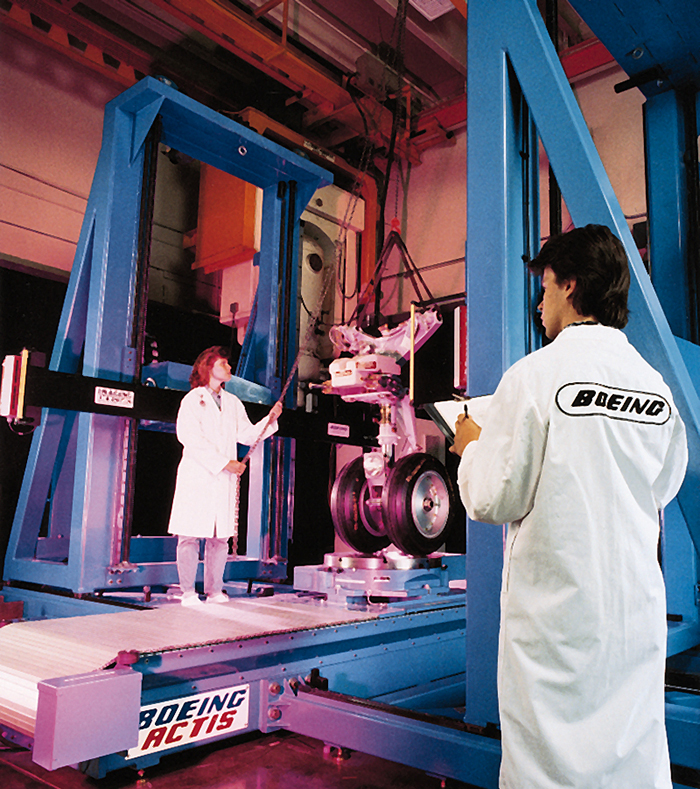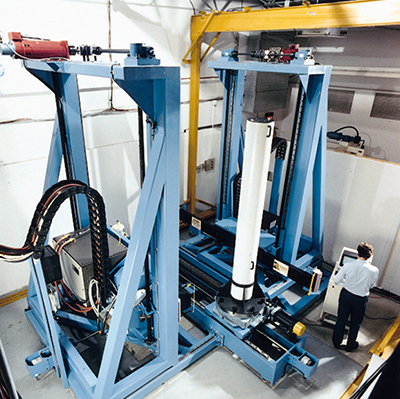
The Inside View
Technology developed for the Apollo lunar landing program has come full circle—launched to the moon and then finding a home back here on Earth—advancing the art of computer imaging inspection.
Computed tomography, widely known as CT or CATScan, is a medical diagnostic technique for comprehensive body scanning. It incorporates digital image processing technology that traces its origin to NASA research and development performed as a prelude to the Apollo program. Millions of people around the world benefit each year from the medical applications of this technology.
This same capability has found secondary utility as an aerospace, and general industrial tool-—the Advanced Computed Tomography Inspection System, or ACTIS. In its medical role, CT scans the human body for tumors or other irregularities. The ACTIS system, on the other hand, finds defects in structures and components, be they castings, assemblies, rocket engines, or nozzles. The system helped NASA's Space Shuttle engineers characterize structural assemblies by producing high-quality CT images. These images demonstrated the ablative properties of various solid rocket motor nozzle assembly materials, revealing anomalies at bondline interfaces. Flaws such as these could cascade into mission failures if not detected.
For Marshall Space Flight Center (MSFC), Bio-Imaging Research, Inc. (BIR), Lincolnshire, Illinois, developed an industrial inspection system that employs CT technology for nondestructive evaluation. The system, designed and built by BIR under contract to NASA, was installed in 1988. Two years later, Boeing Aerospace in Seattle, Washington purchased an ACTIS system for nondestructive CT inspection of a variety of commercial and military aerospace components.
"ACTIS has upheld NASA's reputation for technology that benefits industry and science," advises Richard Bernardi, BIR's Vice President for Business Development. It was used to view the interior of a sealed centennial "time capsule"—an accomplishment that was featured in several national publications such as National Geographic.
Cross-sectional CT images offer more detail than radiographic images. The equipment's high-speed scanning feature offers the capability for 100 percent inspection in a production environment.
Looking back in time, ACTIS was used to examine the skull and caudal vertebrae of a Tyrannosaurus Rex while the fossils were still imbedded inside their rock matrix. The images helped paleontologists determine the best way to recover the valuable fossils undamaged.
More recently, yet another successful ACTIS spinoff took place. The NASA MSFC ACTIS system proved the feasibility of CT inspection of 55 gallon drums of radioactive waste for the U.S. Department of Energy (DOE), based on tests with surrogate (cold) drums. There are more than one million drums of waste dating back to the beginning of the atomic era. Located in interim storage, these drums are subject to corrosion and potential leakage. They cannot be transported across state lines or permanently disposed of until they have been examined (characterized) to prove that they neither contain more than one-half percent free liquid, nor that the drum wall has lost integrity.
Identifying these conditions is ideal for computed tomography. According to Bernardi, preliminary tests on cold surrogate drums at MSFC were so successful, DOE has since invested in a $6 million BIR program to develop and field test a transportable (mobile semi-trailer), two-million volt x-ray CT scanner. That hardware uses many of the design principles and elements similar to the BIR ACTIS CT scanner currently at NASA's Marshall Space Flight Center. The mobile drum inspection unit uses a combination of x-ray and gamma-ray technology to "fingerprint" the source of radioactivity. Characterization is essential to decision making on how to treat or transport the waste.
Testing of this new technology application that fingerprints nuclear waste drums is also underway at several DOE sites. Labeled the Waste Inspection Tomography (WIT) system, the equipment promises to revolutionize the nuclear waste drum characterization process.

Computed tomography, widely used in the medical field, has proven invaluable to locate imperfections in aerospace components. This Advanced Computed Tomography Inspection System can scan anything from small turbine blades, auto parts, and drums of nuclear waste to rocket assemblies.

Industrial inspection system, built by Bio-Imaging Research, is ideal for nondestructive testing of aerospace structures and components. The technology is rooted in NASA’s Apollo moon landing project.













